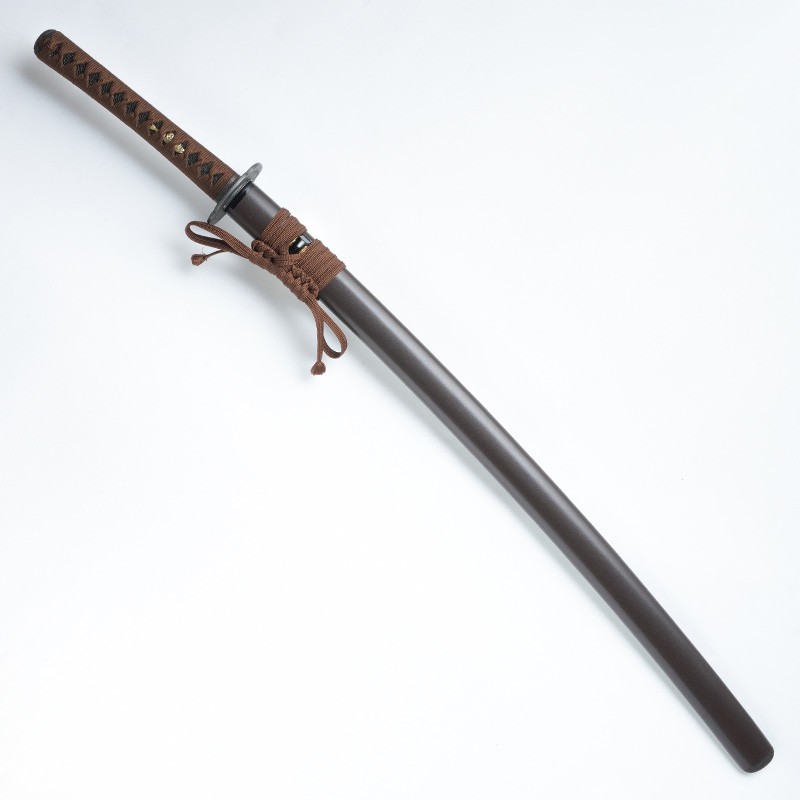














More informations about this product
The Iaito Shinto Higo Koshirae 新刀肥後拵 pays tribute to the sword mountings of the early Edo period. This period began with Tokugawa Ieyasu’s victory at the Battle of Sekigahara in 1600, and continued through the 250 years of 'peace' that Japan experienced after its reunification. In the classification of Japanese swords, this is the Shinto 新刀 period.
This quieter period allowed craftsmen to raise the manufacture of swords to the field of art, in addition to a tool of war. The quenching lines and fixtures had then become very aesthetic.
This montage was created from the swords of Hosokawa Tadaoki (1563-1646), Lord of the ancient province of Higo, now Kumamoto, on the island of Kyushu. Son of daimyo, he appeared on the battlefield at the age of 13-15 years under the aegis of Oda Nobunaga. He married Tamako, daughter of Akechi Mitsuhide, one of Nobunaga’s war generals. He then approached Hideyoshi Toyotomi, then Tokugawa Ieyasu. The latter will give him the Higo estate in gratitude for his participation in the victory of Sekigahara.
Hosokawa Tadaoki was also an experienced swordsman, excelling in poetry, painting, and particularly in the art of the tea ceremony. Rallying the power of the sword to the refinement of the arts of tea, he was an artist, expert and aesthete confirmed.
The dark brown color of the assembly (lacquer, braiding, sageo) recalls the color of matured and dried tea leaves, color that can be found on some of its historical montages like the 'Kasen Koshirae'.
The handle is slightly curved (concave), Ryūgo shape (立拵 - hourglass-shaped). The Fuchi, Kashira and Kojiri are 'en suite' and rounded. The assembly parts are typical of the work and achievements of the craftsmen of the province of Higo.
The blade type for this fixture is a semi-heavy blade, approximately 970g.
Nagasa length possible from 2.20尺 (66.6cm) to 2.70尺 (81.8cm).
size charts (see attached table of recommended sizes)
Hamon: Suguha (straight line).
Habaki: Shonai (old-fashioned design), made of brass. Seppa in blackened brass.
Tsuba: Tsuba Kasuga (Spring Sun - 春 日), quadrilobed (mokko gata), blackened iron.
Fuchi/ Kashira/ Kojiri: Higo model suite pieces in blackened iron, Higo Ishime pattern (stone grain) of superior quality in reproduction of the time.
Same: in Galuchat (Roussette or Raie), Black color.
Menuki: Salmon (Shake - 鮭) Symbol of luck, in Japan it is frequently an offering to the gods in Shinto rituals.
Tsukaito: Genuine Brown Silk Hineri Maki Handle Braiding (Chairo - 茶 色).
Sageo: Genuine Brown Silk (Chairo - 茶 色).
Saya : Hon Chai Ishime 本茶石目塗り, Saya lacquered matte brown top (fine grain), Magnolia wood, Kojiri in suite with Fuchi-Kashira, and Shitodome gilded.
The Minosaka Workshops :
The Iaito we offer come from Minosaka workshops in Gifu, Japan, and are manufactured in their workshop in Japan.
Gifu is one of the top places known for the forging of traditional sabres, including the Mino tradition, dating from the 14th century. Minosaka workshops are Iaito’s leading producers of tradition.
This traditional workshop manufactures its chrome-plated Zamak Iaito (Zinc and Aluminum alloy with some Copper) which is stainless.
This non-ferrous alloy makes the Iaito blunt and unsharpenable:
They are practical tools for Kata, without contact between the blades.
Items that may interest you
Share your opinion
error Your review appreciation cannot be sent
feedback Report comment
check_circle Report sent
error Your report cannot be sent